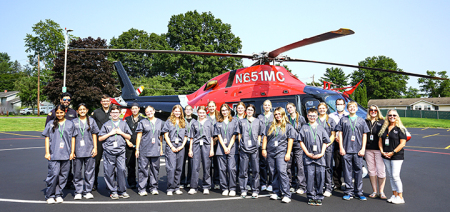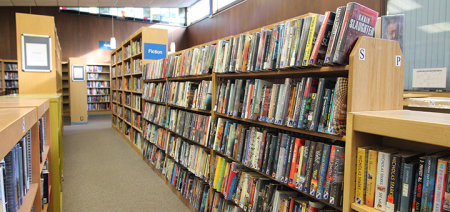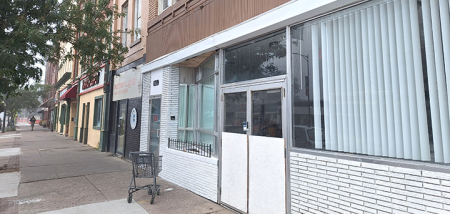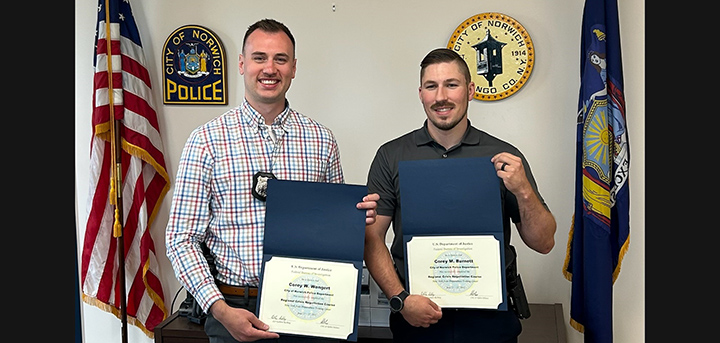Trip To Italy Part III: The Lady Madonna
Published:
November 8th, 2006
By:
Mary Musson
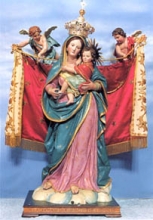
By Mary Musson
Correspondent
She’s magnificent! Tall, elegant, with a face to die for and an expression that invites you to stare. It’s amazing what a little plaster, paint and spectacular devotion to Jesus’ mother can produce. She is Maria, Queen of the Martyrs, and she is the patron saint of fishermen in my parent’s hometown, Molfetta, Italy. Because this is a place on the Adriatic with a still viable fishing industry, the feast in her honor which takes place yearly the first week of September is a time for celebration. The party goes on for a week and it is on a grand scale with street illuminations, processions, band concerts, fireworks late into the night, Mass every day, strolling every evening and of course, encounters. This is a time when many expatriate native sons and daughters and their families come home from such faraway outposts as Australia, Venezuela, Buenos Aires and the largest group with a similar feast in the United States in Hoboken, N.J.
The Molfettese have often left home to work, a condition of living in what was once a poor part of Italy, a region known as Puglia located on the calf of the Italian boot with its stone, its olive groves, its sea and little else. All of that has changed, of course, and this region is today thriving in industry and construction. Molfetta is now a town of 70,000 people and the average cost of a home, a condominium in a four- to six-story building costs about $300,000. The reason for all this progress can be summed up in one word: character. The men who left Molfetta to work abroad after World War II were marked by pride, devotion to family, ambition and the single-minded drive to make money in whatever country would have them and buy property in their home town. This is the reason my father and so many of my uncles left Molfetta and worked in outposts around the world, living in dorms and boarding houses with other Southern Italian males and sending money home every month. Sometimes they stayed away for years at a time, returning home to children they barely knew and wives who were a little hard to dominate since they had managed the homefront quite capably during their absence. Therefore, the whole structure of the family took its form as a strong matriarchal society where women ruled and men pretended they did on the few months they were home – every three years or so.
It was this family sacrifice that bought the property their children inherited and so a teacher today might only earn $14,000 per year and an engineer $25,000 but, they live in a residence they own. Few people have a mortgage and many have additional income from rental properties and olive and almonds groves, which not only produce saleable commodities but also maintain real estate interests. As I walked the streets of Molfetta during my month-long stay there, I understood well how the system worked and couldn’t help but be proud of the men in my own family who left and sent money home to make Molfetta what it is today – a bustling, thriving place with a strong sense of community and much to offer to both the young and the old. Whenever I saw an octogenarian playing cards at a cafe, or strolling with his wife in the park or wheeling a grandbaby in a stroller, I thought about the uncles in my family who never made it to their goal: a sunny and well-earned retirement in Molfetta. Men like my dear uncle Leo, one of the most elegant men I’ve ever known who died in Hoboken just months before he could return home, and Uncle John, who only reaped a few years in his hometown before he too died, and Uncle Mauro, whose children made their permanent home in New Jersey and who just couldn’t return; he had lost them to America forever.
And then there was my father, Saverio. He exemplified the reason why the Italians were successful abroad. It wasn’t just hard work, ambition and smarts – certainly other nationalities had similar qualities – no, what brought the Molfettese success was the fact that they were highly skilled at what they did. My father was a sculptor of marble stone with an enormous talent for carving a piece of granite into a three-dimensional work of art. Between the ages of 14 and 24, he worked in Trani, a neighboring town known for its fabulous native stone, and attended the Julio Cozzoli School of Design nights and weekends to hone his skills and rise in rank from marmista, one who laid the stone, to scapellino, one who worked it, to scultore, one who carved it into the altar pieces and cemetery tombs and fireplace mantles in the palaces and villas of the very rich.
It was this training that took him to Argentina. When Evita Peron toured Europe after the war, she told Italy’s leaders, “Your people are hungry and poor. My country is rich in grain and meat. I will feed your people, but in exchange send me your trained workers to elevate my country to European standards.” So they went: carpenters, wood workers, tile men, ceramists, civil engineers, construction workers of all levels and, of course, the famous stone masons of Puglia, my father among them. While the other men sent their paychecks home monthly, Dad no longer needed to since as the eldest son he had already contributed to the family fund which helped marry off his three sisters. He was now free, at 32 years of age, to work for his own future, one in which he saw himself married with his wife by his side. You see, unlike so many of the other Italian expatriates, Dad fell in love with Argentina – its climate, its lifestyle and especially its people and within months of arriving he sent for his girlfriend, my mother Anna, to join him there. Because of immigration law, she couldn’t go unless she was his wife, so they married by proxy and she joined him there a year later. They built a wonderful life in that country and gave me, their only child born during their first year together, the greatest gift parents can give their children: their happiness.
While my parents stayed in Argentina, other Molfettese men continued to work and send money home and eventually retired in their home town and lived well on their foreign pensions, savings and rent from the land and houses they had purchased. Yes, I understood it all very well and was so very proud to be among these people, especially when they were in a celebratory mood because it is well-known fact that Italians are real party animals. This could be the reason why my blond, blue-eyed son Adam who looks like a WASP wonder, but who is Italian to the core with his outgoing personality, charm and tireless energy, led so many celebrations during his teen years at our own Chenango County party hot spots like the quarry on Norwich’s West Hill. And speaking of my children, how I wish they had been with me during this trip. Although they are French, English, German and Irish on their father’s side with names like Musson, Wilber, Rowe and Gillette in their background, on my side of the family they are 100% Italian and it is my fondest dream that a trip to Italy will be in their future. This should not be a hard sell actually, as my twin daughters Tina and Diana were quite taken with photos I brought back of Lake Como.
But, it is Molfetta I want them to see and I want them to meet the lady madonnas of our own family: my aunts, Zia Giuseppina, mom’s elder sister, 86 years old, rim-rod straight and still wearing high heels during her weekly trips to the cemetery; Zia Lina, dad’s youngest sister, 84, and still ruling her family with an iron will; and my darling Zia Vincenza, 83, widow of mom’s brother Sergio, who cooked me some of the greatest regional food I’ve ever tasted and who went to a great deal of trouble to impress me. On my visit to her home (one of 12 family homes I visited during my trip) she made Carteddate for me, thin pieces of fried dough covered with a sticky syrup.
This is a very special treat, one presented only at Christmas time and although I didn’t give it much attention when she served it to me, my cousins later told me what was involved in the preparation of this Pugliese specialty. This elderly woman had gone to the fruit vendor where she had bought many pounds of grapes, hauled them up to her house, boiled them gently in a big pot to soften them, put them in a linen pillow case, hung it over her sink and squeezed the heck out of it producing a sweet juice which she then boiled down, stirring gently for about two hours and producing vin coto, the Italian peasant version of maple syrup. Then she had made a dough of flour, olive oil and white wine. She had rolled it out thin and cut it into two by four-inch strips which she then dried overnight on her kitchen table. The morning of my meal with her, she had fried each piece in oil, shaped them into rosettes before they cooled, poured vin coto over them and presented them to me as a love offering.
Well, I felt not only loved, but indebted and so I spent a lot of time with her during my stay, going to Mass with her as often as possible and just sitting at the kitchen table and talking with her. I questioned her about my mother, one of her best friends growing up, and life in their hometown by the sea. I drew memories from her which she savored with a sweet smile on her face and I made memories of my own. I did this with all my aunts, and they loved it as all elderly people do. So many stories to tell, but often no one there to listen to them. Well, I listened and have enough material to write several books and someday I will, just to honor their existence, these lady madonnas I call family.
As for the famous one, the statue of Mary Queen of the Martyrs, I saw a great deal of her during the week-long celebration. I saw her come out of her church carried on the shoulder of men dressed as ancient fishermen, barefoot and jubilant, carrying wooden oars in an upright position like swords of protection. When her procession came near I gawked at her dress, a fishermen’s net of solid gold draped over the plaster and loaded with gold chains, rings, bracelets and watches – love offerings from believers who offered their precious possessions in exchange for graces. I saw her carried aboard a boat flotilla which then toured the large harbor as young men and boys dove into the sea, which was now safe for them because of her protection. A few days later I saw her enshrined in the Cathedral where pilgrims from many parts of the world came to pay their respects. Then after a week, she returned to her church on the edge of town, a church built on the remains of an ancient hospital used by Crusaders in the 12th Century.
On my last night in Molfetta, I asked my cousins if they would take me for a walk to the sea wall that protects the harbor. I told them I needed some time alone and made my way to a point overlooking the sea. I took out a small velvet pouch which contained bits of my mother’s hair which had been cut during the last visit by her hairdresser in our home three days before she died. I bent down and picked up a heavy stone and added it to the pouch thinking of my father and all the stone he had cut in his life. As I threw the pouch into the sea, I felt this overwhelming peace come over me. They were home now, the most important lady madonna of my life and her man.
Part IV of this five-part series will appear in Thursday’s Evening Sun.
Author: Mary Musson - More From This Author
Comments
